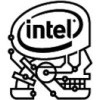- Qualcomm Launches Snapdragon 4 Gen 2 Mobile Platform
- AMD Launches Ryzen PRO 7000 Series Mobile & Desktop Platform
- Intel Launches Sleek Single-Slot Arc Pro A60 Workstation Graphics Card
- NVIDIA Announces Latest Ada Lovelace Additions: GeForce RTX 4060 Ti & RTX 4060
- Maxon Redshift With AMD Radeon GPU Rendering Support Now Available
Building an Affordable “Skulltrail” System

Intel’s new dual-socket enthusiast platform is in every sense impressive, but due to the price of the recommended CPUs, owning one is a dream for many. We’re taking a look at a few ways to build your very own full-featured 8-core “Skulltrail” machine for a price that’s a lot easier to manage.
Page 1 – Introduction
Earlier this month, we posted an in-depth look at the platform formally known as Skulltrail. It’s now called “Intel Dual Socket Extreme Desktop Platform”, which quite frankly, is a name that rolls right off the tongue. In case you missed it, “Skulltrail” is a platform, consisting of the Intel D5400XS workstation motherboard and two Intel Core 2 Extreme QX9775 processors, clocked at 3.2GHz. Paired together, an 8-Core beast is created. The term “High-End”, at that point, might be an understatement.
Throughout that article, we came to multiple conclusions. The most obvious is that when you take the path Intel lays out and throw two QX9775 processors into the Skulltrail board, you essentially have the fastest desktop system money can buy. Of course, that’s without taking overclocking into consideration, but from a “stock” standpoint, it doesn’t get any better.
If you are not familiar with the “Skulltrail” platform as a whole or want to learn more, we encourage you to take a look at our preview in order to familiarize yourself with what the platform entails.
Until now, pricing for the individual components has been kept under wraps, although leaks from months past have given us all a general idea of what to expect. Now, Intel has made the platform official, while releasing pricing information at the same time.
Warning! Before reading further, we recommend having someone strap you to the chair you are in, remove any hot beverage from your hand and turn off any angry music that may be playing.
Each QX9775 Extreme Quad-Core processor, clocked at 3.2GHz, will be sold to retailers for $1,499 each. That means that the price to you will be slightly higher – possibly around the $1,650 mark. The D5400XS motherboard, which was rumored to be sold at $500 upon release, is actually a bit higher, at $649.
You are reading that right. To build the fastest desktop machine known to man, the motherboard and CPUs alone will set you back $4,000. Add in a chassis, two video cards, some hard drives, audio and some optical disc drives, and you have a system valued at close to $6,000.
Burn your lap? See, we told you to put the drink down.
Is There Such Thing As Budget “Skulltrail”?
The answer to that question will vary depending on your interpretation of the word “budget”. Our considerations will still be more expensive than most custom-built PCs, but that comes with the territory of an 8-Core rig, and is not helped at all by the high price of the motherboard. Compare the BMW 328i to the BMW M3. The former is better overall in quality when compared to a regular car, but is still affordable for most people. The M3 on the other hand, delivers power that only few will fully tap into, and also happens to come with a premium price.
When I decided to look into building a budget Skulltrail rig, I had a goal set in mind to make sure the tower did not cost more than $2,500… and even that was a tight goal considering the D5400XS motherboard is responsible for $649 alone. One option would be to just use a regular server motherboard, but since they are not designed for enthusiast use, performance and the overall feature-set will be lacking, especially if you plan to get into overclocking.
I was up to the challenge. Could I build a $2,500 Skulltrail tower? The answer is on the next page, but we all know you are a poster child for having incredible patience, so you will finish this page first.
You might be asking, “I can use other processors in place of the QX9775?”, and that would be correct. Because Skulltrail utilizes standard LGA771 sockets, all processors in that class are compatible… even the QX9775 equivalent, the Xeon X5482.
Because we are able to choose a standard Xeon instead of the QX9775, our options are far more reasonable, price-wise and selection-wise. For our test build, we chose to use two Xeon E5410s for example, clocked at 2.33GHz. While that’s a rather sizable drop from the QX9775’s 3.2GHz clock speed, these cost 80% less, making the purchase a lot easier to stomach. So instead of $3,300 for dual QX9775s, dual E5410s can be had instead for $600.
You might think I am bagging on the QX9775 for being so expensive, but in truth, I’m not. Premium products have always existed, and we’ve taken a look at a fair amount of Intel’s premium products ourselves. Like anything, they have their place, and for those who want the best of what’s out there, the QX9775 is a fantastic offering. But in reality, it’s just not feasible for most people.
Let’s make things easier to understand by comparing the QX9775 to our budget Xeon and other offerings:
|
Specification
|
Intel QX9775
|
Intel X5482
|
Intel E5450
|
Intel E5420
|
Intel E5410
|
| Model |
Core 2 Extreme QX9775
|
Xeon X5482
|
Xeon E5450
|
Xeon E5420
|
Xeon E5410
|
| Clock Speed |
3.2GHz
|
3.2GHz
|
3.0GHz
|
2.50GHz
|
2.33GHz
|
| FSB |
1600MHz
|
1600MHz
|
1333MHz
|
1333MHz
|
1333MHz
|
| L2 Cache |
12MB
|
12MB
|
12MB
|
12MB
|
12MB
|
| Multiplier |
400 x 12
Unlocked |
400 x 12
Unlocked |
333 x 9
Locked |
333 x 7.5
Locked |
333 x 7
Locked |
| TDP |
150W
|
150W
|
80W
|
80W
|
80W
|
| sSpec Number |
SLANY
|
SLANZ
|
SLANQ
|
SLANV
|
SLANW
|
| Reseller Price |
$1,499
|
$1,279
|
$915
|
$316
|
$256
|
There are a few interesting things to note here. First is the fact that the Xeon equivalent to the QX9775 costs $1,279 – a full $220 less. Because of this, that processor may look attractive, but sadly, it’s not that easy. The fact of the matter is, it’s very difficult to find high-end Xeon’s in stock anywhere, so a special order usually must be placed. The QX9775 on the other hand, is supposed to be readily available from numerous stores.
That’s one thing you will find out about Xeon’s in general. They are not stocked as well as desktop chips more often than not, partly due to the fact that there are so many models available. Current count shows 12 Quad-Core 45nm Xeon’s alone, so it’s near impossible for an e-tailer to keep good stock.
Oddly enough, if you have no intentions of going the high-end route, your choices are made so much easier since affordable Xeons are available from most popular e-tailers, including the E5410 we are taking a quick look at today.
With all of that said, it’s time to take a look at building Skulltrail from a few different angles, including examining other required components… all while trying to keep the price well within reason. This will be fun.
Support our efforts! With ad revenue at an all-time low for written websites, we're relying more than ever on reader support to help us continue putting so much effort into this type of content. You can support us by becoming a Patron, or by using our Amazon shopping affiliate links listed through our articles. Thanks for your support!






